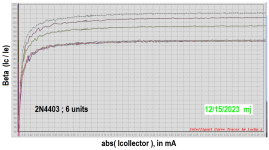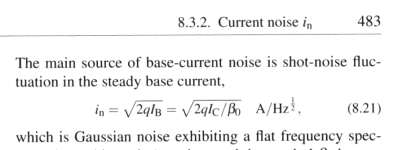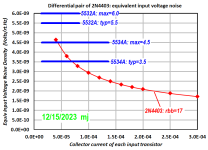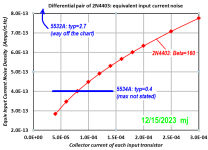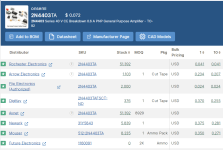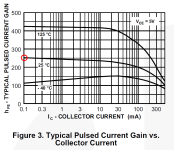John Curl filed a patent application in March of 1976, which eventually was granted as US Patent # 4,035,737. His invention was a moving coil pre-preamplifier which used the low noise {for 1976!} discrete transistors 2N4403 and 2N4401. I wondered how well those old transistors would perform in a Moving Magnet RIAA preamp, where the current noise is paramount because of the 47K cartridge loading resistor.
To get started, I looked up the base resistance r_bb of those devices in The Art Of Electronics, 3rd Edition (by Horowitz and Hill). As expected, the PNP's base resistance was lower (r_bb = 17 ohms !) so I focused upon a moving magnet design with PNP input devices: 2N4403. The other transistor parameter needed for noise calculations is the current gain Beta, which I measured on six units using a curve tracer. As Figure 1 shows, Beta exceeded 160 on all six devices, for all collector currents greater than 30 microamps. Thus I used Beta=160 in the noise calculations.
Figure 2 is the equation for the input voltage noise density of a differential pair of bipolar transistors. (It's from George Erdi's ISSCC paper on the super low noise LT1028; written in 1986). As you can see, voltage noise density varies with temperature, collector current, and base resistance r_bb. (notice that Beta does not appear)
Figure 3 is the equation for the input current noise density of a bipolar transistor. (From Horowitz and Hill TAOE, 3rd Edition). Current noise density varies with collector current and with Beta. (But not temperature or base resistance).
The only one of these variables under the control of the circuit designer, is collector current. So I plotted input voltage noise, and input current noise, when varying collector current. These plots are Figure 4 and Figure 5, respectively.
The voltage noise plot in Figure 4 contains a few surprises. First of all, the 2N4403's input voltage noise {red curve} is better than the (dual) 5532A, for every single collector current I tried (40uA <= Icollector <= 300uA). Second, the 2N4403 noise turns out to be less than the 5534A, for every collector current greater than 70 uA. Not bad for a fifty year old jellybean part.
The current noise plot in Figure 5 tells another story. As mentioned above, the very low base resistance of the 2N4403 makes no difference to the input current noise; only Beta and collector current matter. The 2N4403 is lower noise than the 5534A at low currents (Icoll < 80uA) and higher noise than the 5534A at high currents.
Like our colleagues at Philips (later Signetics) who designed the original 5534A, we have discovered there is a "sweet spot". Namely, at 70-80 microamps of collector current in each input 2N4403. This sweet spot gives an input current noise density of 0.4 pA per rtHz (same as the "Typical" spec for 5534A), and an input voltage noise density of 3.3 nV per rtHz (while 5534A "Typical" spec is 3.5 nV per rtHz). Both of these are way, WAY better than the dual 5532A's specs.
Now, if you wanted to build a moving coil preamp (as John Curl did in 1976) instead of moving magnet, you'd be interested in the input voltage noise density. Why? Because the 47K cartridge loading resistor of MM preamps goes away, and is replaced by a ~100 ohm loading resistor for moving coil cartridges. So the (CurrentNoise * LoadingResistor) contribution to noise voltage becomes negligible. Let's go back to Figure 4 (2N4403 voltage noise) and see what can be done....
Cowabunga! Simply by raising the collector current, we can decrease the input voltage noise density dramatically. At Icollector = 250 microamps per transistor, we get a 2x reduction in noise compared to the 5534A. And, as John Curl's patent carefully explains, by connecting several of these transistors in parallel, we can reduce noise yet further. Not bad at all, for a fifty year old jellybean part.
_
To get started, I looked up the base resistance r_bb of those devices in The Art Of Electronics, 3rd Edition (by Horowitz and Hill). As expected, the PNP's base resistance was lower (r_bb = 17 ohms !) so I focused upon a moving magnet design with PNP input devices: 2N4403. The other transistor parameter needed for noise calculations is the current gain Beta, which I measured on six units using a curve tracer. As Figure 1 shows, Beta exceeded 160 on all six devices, for all collector currents greater than 30 microamps. Thus I used Beta=160 in the noise calculations.
Figure 2 is the equation for the input voltage noise density of a differential pair of bipolar transistors. (It's from George Erdi's ISSCC paper on the super low noise LT1028; written in 1986). As you can see, voltage noise density varies with temperature, collector current, and base resistance r_bb. (notice that Beta does not appear)
Figure 3 is the equation for the input current noise density of a bipolar transistor. (From Horowitz and Hill TAOE, 3rd Edition). Current noise density varies with collector current and with Beta. (But not temperature or base resistance).
The only one of these variables under the control of the circuit designer, is collector current. So I plotted input voltage noise, and input current noise, when varying collector current. These plots are Figure 4 and Figure 5, respectively.
The voltage noise plot in Figure 4 contains a few surprises. First of all, the 2N4403's input voltage noise {red curve} is better than the (dual) 5532A, for every single collector current I tried (40uA <= Icollector <= 300uA). Second, the 2N4403 noise turns out to be less than the 5534A, for every collector current greater than 70 uA. Not bad for a fifty year old jellybean part.
The current noise plot in Figure 5 tells another story. As mentioned above, the very low base resistance of the 2N4403 makes no difference to the input current noise; only Beta and collector current matter. The 2N4403 is lower noise than the 5534A at low currents (Icoll < 80uA) and higher noise than the 5534A at high currents.
Like our colleagues at Philips (later Signetics) who designed the original 5534A, we have discovered there is a "sweet spot". Namely, at 70-80 microamps of collector current in each input 2N4403. This sweet spot gives an input current noise density of 0.4 pA per rtHz (same as the "Typical" spec for 5534A), and an input voltage noise density of 3.3 nV per rtHz (while 5534A "Typical" spec is 3.5 nV per rtHz). Both of these are way, WAY better than the dual 5532A's specs.
Now, if you wanted to build a moving coil preamp (as John Curl did in 1976) instead of moving magnet, you'd be interested in the input voltage noise density. Why? Because the 47K cartridge loading resistor of MM preamps goes away, and is replaced by a ~100 ohm loading resistor for moving coil cartridges. So the (CurrentNoise * LoadingResistor) contribution to noise voltage becomes negligible. Let's go back to Figure 4 (2N4403 voltage noise) and see what can be done....
Cowabunga! Simply by raising the collector current, we can decrease the input voltage noise density dramatically. At Icollector = 250 microamps per transistor, we get a 2x reduction in noise compared to the 5534A. And, as John Curl's patent carefully explains, by connecting several of these transistors in parallel, we can reduce noise yet further. Not bad at all, for a fifty year old jellybean part.
_
Attachments
Last edited:
Nice post Mark 👍John Curl filed a patent application in March of 1976, which eventually was granted as US Patent # 4,035,737. His invention was a moving coil pre-preamplifier which used the low noise {for 1976!} discrete transistors 2N4403 and 2N4401. I wondered how well those old transistors would perform in a Moving Magnet RIAA preamp, where the current noise is paramount because of the 47K cartridge loading resistor.
To get started, I looked up the base resistance r_bb of those devices in The Art Of Electronics, 3rd Edition (by Horowitz and Hill). As expected, the PNP's base resistance was lower (r_bb = 17 ohms !) so I focused upon a moving magnet design with PNP input devices: 2N4403. The other transistor parameter needed for noise calculations is the current gain Beta, which I measured on six units using a curve tracer. As Figure 1 shows, Beta exceeded 160 on all six devices, for all collector currents greater than 30 microamps. Thus I used Beta=160 in the noise calculations.
Figure 2 is the equation for the input voltage noise density of a differential pair of bipolar transistors. (It's from George Erdi's ISSCC paper on the super low noise LT1028; written in 1986). As you can see, voltage noise density varies with temperature, collector current, and base resistance r_bb. (notice that Beta does not appear)
Figure 3 is the equation for the input current noise density of a bipolar transistor. (From Horowitz and Hill TAOE, 3rd Edition). Current noise density varies with collector current and with Beta. (But not temperature or base resistance).
The only one of these variables under the control of the circuit designer, is collector current. So I plotted input voltage noise, and input current noise, when varying collector current. These plots are Figure 4 and Figure 5, respectively.
The voltage noise plot in Figure 4 contains a few surprises. First of all, the 2N4403's input voltage noise {red curve} is better than the (dual) 5532A, for every single collector current I tried (40uA <= Icollector <= 300uA). Second, the 2N4403 noise turns out to be less than the 5534A, for every collector current greater than 70 uA. Not bad for a fifty year old jellybean part.
The current noise plot in Figure 5 tells another story. As mentioned above, the very low base resistance of the 2N4403 makes no difference to the input current noise; only Beta and collector current matter. The 2N4403 is lower noise than the 5534A at low currents (Icoll < 80uA) and higher noise than the 5534A at high currents.
Like our colleagues at Philips (later Signetics) who designed the original 5534A, we have discovered there is a "sweet spot". Namely, at 70-80 microamps of collector current in each input 2N4403. This sweet spot gives an input current noise density of 0.4 pA per rtHz (same as the "Typical" spec for 5534A), and an input voltage noise density of 3.3 nV per rtHz (while 5534A "Typical" spec is 3.5 nV per rtHz). Both of these are way, WAY better than the dual 5532A's specs.
Now, if you wanted to build a moving coil preamp (as John Curl did in 1976) instead of moving magnet, you'd be interested in the input voltage noise density. Why? Because the 47K cartridge loading resistor of MM preamps goes away, and is replaced by a ~100 ohm loading resistor for moving coil cartridges. So the (CurrentNoise * LoadingResistor) contribution to noise voltage becomes negligible. Let's go back to Figure 4 (2N4403 voltage noise) and see what can be done....
Cowabunga! Simply by raising the collector current, we can decrease the input voltage noise density dramatically. At Icollector = 250 microamps per transistor, we get a 2x reduction in noise compared to the 5534A. And, as John Curl's patent carefully explains, by connecting several of these transistors in parallel, we can reduce noise yet further. Not bad at all, for a fifty year old jellybean part.
_
For those who really want to squeeze the input current noise density even lower, because all you really care about is Moving Magnet cartridges with 47K load resistors, allow me to point out: noise voltage is independent of transistor Beta, but noise current is inversely proportional to SQRT(Beta). Higher Beta gives lower current noise. (Amen!) If you can increase Beta by 20%, input current noise density will decrease by 8.7%, and that's an advantage worth pursuing. If somehow you can manage to increase Beta by 60%, input current noise density will decrease by 21% --- So let's do it!
Circuit designers using discrete bipolars, have options and stunts and available tricks which monolithic IC designers do not: how many different ways can you think of, to increase the Beta of a pair of 2N4403 discretes? There are more than one option; why not apply them all? Maximize Beta, minimize input current noise density, feel good about yourself. Treat yourself to an Austin Powers self-congratulation: Yeah Baby.
_
Circuit designers using discrete bipolars, have options and stunts and available tricks which monolithic IC designers do not: how many different ways can you think of, to increase the Beta of a pair of 2N4403 discretes? There are more than one option; why not apply them all? Maximize Beta, minimize input current noise density, feel good about yourself. Treat yourself to an Austin Powers self-congratulation: Yeah Baby.
_
Attachments
Nice deep dive, thanks for writing it up 
Take a look also at 2SB737, it sort of took over when the 4401 went NLA.
For moving coil, and from basically the same era, the Leach complementary common base design always struck me as elegant. I wonder how quiet you could really make one?
https://leachlegacy.ece.gatech.edu/headamp/
Take a look also at 2SB737, it sort of took over when the 4401 went NLA.
For moving coil, and from basically the same era, the Leach complementary common base design always struck me as elegant. I wonder how quiet you could really make one?
https://leachlegacy.ece.gatech.edu/headamp/
Hi Mark, I agree with most of what you wrote, but have some comments on details:
I agree with you that the input noise current is important, but that is because of the high cartridge inductance that makes the source impedance go quite high at high audio frequencies. I assume now that the noise with a connected cartridge is what matters.
I suspect the NE5532A's equivalent input noise current at 1 kHz is mainly 1/f-noise. The 0.7 pA/√Hz datasheet value is much greater than the 0.2532 pA/√Hz shot noise that belongs with the 200 nA typical input bias current (which is the base current of the input transistor, as there is no base current compensation).
You seem to be implicitly assuming here that there is no cartridge connected. Otherwise the noise current mainly flows through the moving coil cartridge, which makes the current noise contribution even more negligible.
By the way, one way to increase hFE is to bias the transistor at a collector-emitter voltage close to the collector-emitter breakdown voltage with open base, but I think the avalanche effects you then get will only make the input noise worse. I never tried it, though, and most simulation models are unreliable in this regime.
I wondered how well those old transistors would perform in a Moving Magnet RIAA preamp, where the current noise is paramount because of the 47K cartridge loading resistor.
I agree with you that the input noise current is important, but that is because of the high cartridge inductance that makes the source impedance go quite high at high audio frequencies. I assume now that the noise with a connected cartridge is what matters.
This sweet spot gives an input current noise density of 0.4 pA per rtHz (same as the "Typical" spec for 5534A), and an input voltage noise density of 3.3 nV per rtHz (while 5534A "Typical" spec is 3.5 nV per rtHz). Both of these are way, WAY better than the dual 5532A's specs.
I suspect the NE5532A's equivalent input noise current at 1 kHz is mainly 1/f-noise. The 0.7 pA/√Hz datasheet value is much greater than the 0.2532 pA/√Hz shot noise that belongs with the 200 nA typical input bias current (which is the base current of the input transistor, as there is no base current compensation).
Now, if you wanted to build a moving coil preamp (as John Curl did in 1976) instead of moving magnet, you'd be interested in the input voltage noise density. Why? Because the 47K cartridge loading resistor of MM preamps goes away, and is replaced by a ~100 ohm loading resistor for moving coil cartridges. So the (CurrentNoise * LoadingResistor) contribution to noise voltage becomes negligible.
You seem to be implicitly assuming here that there is no cartridge connected. Otherwise the noise current mainly flows through the moving coil cartridge, which makes the current noise contribution even more negligible.
By the way, one way to increase hFE is to bias the transistor at a collector-emitter voltage close to the collector-emitter breakdown voltage with open base, but I think the avalanche effects you then get will only make the input noise worse. I never tried it, though, and most simulation models are unreliable in this regime.
By the way, one way to increase hFE is to bias the transistor at a collector-emitter voltage close to the collector-emitter breakdown voltage with open base
Excellent! We will add it to the ever-growing list of different ways to increase Beta in a differential pair of discrete PNP bipolars. Including the subversive maneuver displayed in the attachment to post #4.
5534A worshippers continuously chant their mantra CURR -- RENT -- NOISE -- CURR -- RENT -- NOISE with great fervor. So I thought it would be pleasant to give those kind folks some tools, to improve upon the 5534A's current noise specs using old transistors. Which several distributors have on their shelves today.
_
Attachments
[2N]4403 have low minimum hfe at low current min 30 at 100µA
Hi, please take a look at attachment #1 of post #1 in this Forum discussion thread. It shows measured data on real 2N4403s. Sometimes this type of data is plotted on semilog axes, I realize; but my curve tracer only plots on linear axes, sorry.
Beta = hfe was measured to be >160 amps per amp, on all samples tested, for all collector currents above 30 microamps. The key word here is: measured .
Luckily, since I'm a DIY hobbyist and I'm not doing high volume manufacturing, I only need four 2N4403s with high Beta. Two for the left channel and two more for the right. And luckily for me, the first six devices I pulled out of my bag this morning were all high Beta. Also luckily for me, Fairchild's datasheet (attached to post #4) says the "typical" 2N4403 has a Beta of 250 at Icollector = 100 microamps. I repeat: Typical Beta = 250.
Thus I feel quite comfortable predicting that every time I buy a bag of 20 pieces of 2N4403 (for USD 5.42), I'll be able to find at least 4 units with sufficiently high Beta. It's not guaranteed, but it is very very likely.
_
Thus I feel quite comfortable predicting that every time I buy a bag of 20 pieces of 2N4403 (for USD 5.42), I'll be able to find at least 4 units with sufficiently high Beta. It's not guaranteed, but it is very very likely.
_
Attachments
The only things you need, to calculate the noise voltage and noise current yourself, are the numerical values of Beta and r_bb. Then just plug them into the equations (Figures 2 and 3 of post #1) on a scientific calculator, and Bob's your uncle. If you so choose, you can perform the calculations within Microsoft Excel. Now you can save the Excel spreadsheet on your computer, for later use to explore other transistor types.
And assuming you can find an accurate value for r_bb. The spec sheets I have don't have it. My 4403 sheet only has NF graphs. The reason I mentioned trying the 5087 is the graphs indicated to me the 5087 would do slightly better at 47K, being able to achieve a NF of .5db whereas the 4403 only achieves a 2db NF. Hard to tell for sure, the 5087 had a graph on the data sheets I have which shows a constant NF value over Ic/Rs, which my 4403 sheet does not have.
The McCormick method of measuring r_bb is often recommended; see attached .pdf And Horowitz & Hill (The Art Of Electronics, 3rd edition) present another approach, including test jigs, in the book. Or you could check whether your transistor(s) happens to be among the devices in listed their r_bb tables.
_
_
Attachments
Wayne at https://waynekirkwood.net/forum/php/index.php looked into this very carefully. You can get better performance than 5532/4 with a discrete design on a REAL MM CARTRIDGE but not by more than a dB or so. But the real champion for MM is NJM 2068. Alas, I think this is now Unobtainium.
In all this, it is important to look at the spectrum of the noise. That is why a properly optimised MC system can be both measured (with all da different weightings) and subjectively quieter than the best MM systems.
This presupposes that electrical noise >10dB below record noise is 'audible' and preferable which is a view I share. But it might just be the bits I use hand carved from solid BS & Unobtainium by virgins
In all this, it is important to look at the spectrum of the noise. That is why a properly optimised MC system can be both measured (with all da different weightings) and subjectively quieter than the best MM systems.
This presupposes that electrical noise >10dB below record noise is 'audible' and preferable which is a view I share. But it might just be the bits I use hand carved from solid BS & Unobtainium by virgins
Bad link, Richard. That one only takes you to the top level, not the REAL MM CARTRIDGE proofs you mention.
I think you might have omitted a couple words. I think perhaps you meant "You can get better performance than 5532/4 with an [all BJT] discrete design on a REAL MM CARTRIDGE but not by more than a dB or so." Maybe you accidentally left the door open to discrete designs using JFETs ---- including paralleled, matched, 2SK170 JFETs. Them babies is dynamite when interfaced to an MM cartridge.
I think you might have omitted a couple words. I think perhaps you meant "You can get better performance than 5532/4 with an [all BJT] discrete design on a REAL MM CARTRIDGE but not by more than a dB or so." Maybe you accidentally left the door open to discrete designs using JFETs ---- including paralleled, matched, 2SK170 JFETs. Them babies is dynamite when interfaced to an MM cartridge.
- Home
- Source & Line
- Analogue Source
- Discrete 2N4403 from 1976, same noise performance in Moving Magnet RIAA preamp, as NE5534A. And better performance than the dual (5532A)
